Opportunity charging is when battery electric buses are charged while out of the depot with the charger generally being located at bus stops or layovers. Opportunity charging is often time constrained because the charging window is the length of a dwell at a bus stop or a layover (typically between 30 seconds and up to 30 minutes in duration). Therefore, opportunity charging normally uses DC chargers which are able to transmit a large amount of power over a short time period.
Typically, opportunity charging tops up the batteries in order to extend the range of battery electric buses but does not fully charge the electric bus batteries. The additional range provided by opportunity charging depends on its duration and the power rating of the charger.
The table below shows the additional range provided by different types of opportunity chargers assuming that a battery electric bus consumes 1.5 kWh per km (electric bus manufacturer specifications gave a range of efficiencies between 1.2 kWh/km and 1.9 kWh/km with heavier buses generally having higher energy use).
Table: Additional range provided by different types of opportunity chargers assuming bus consumes 1.5 kWh/km
|
Charger power rating |
1 min charge (dwell at bus stop) |
10 min charge (duration of layover) |
|
150 kW |
1.7 km |
16.7 km |
|
300 kW |
3.3 km |
33.3 km |
|
600 kW |
6.7 km |
66.7 km |
The cost of purchasing and installing an opportunity charger generally increases with the power rating therefore opportunity chargers are sized to provide the additional range required before the next charge. To reduce the demand on the electricity grid some opportunity chargers have built-in energy storage such as capacitors or batteries. This built-in energy storage allows the opportunity charger to be charged gradually from the electricity grid and then rapidly release the energy to charge the bus.
Not all battery electric buses are compatible with opportunity charging and bus manufacturers may specify a limit for the maximum charging rate that can be used. Therefore, bus operators and public transport contracting authorities should determine whether opportunity charging is required and their requirements for the charging rate before procuring battery electric bus fleet.
The overall advantages and disadvantages of using opportunity charging instead of relying solely on depot charging are discussed in the table below:
Table: Advantages and disadvantages of opportunity charging
|
Advantages |
Disadvantages |
|
|
Current practice is for the capital cost of opportunity charges to be negotiated between the public transport contracting authority and the bus operator on a contract-by-contract basis. However, this is an evolving area of practice which may change as opportunity chargers become more common in New Zealand.
There are three main types of connections between the bus and the charger: plug-in, pantograph, and induction:
The advantages and disadvantages of the charger connection types are shown in the table below:
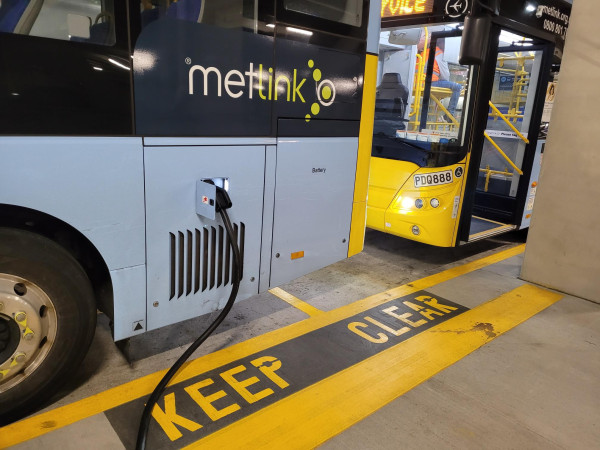
Plug-in charging at Wellington airport. (Source: Lorelei Schmitt)
|
Advantages |
Disadvantages |
|
|
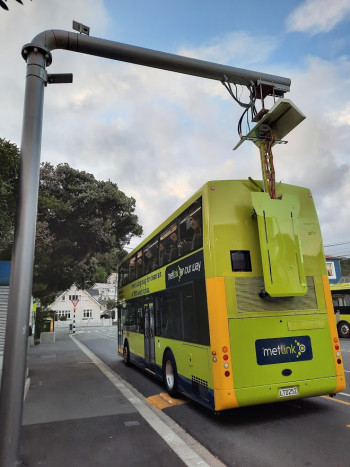
Pantograph charging. (Source: Lorelei Schmitt)
|
Advantages |
Disadvantages |
|
|
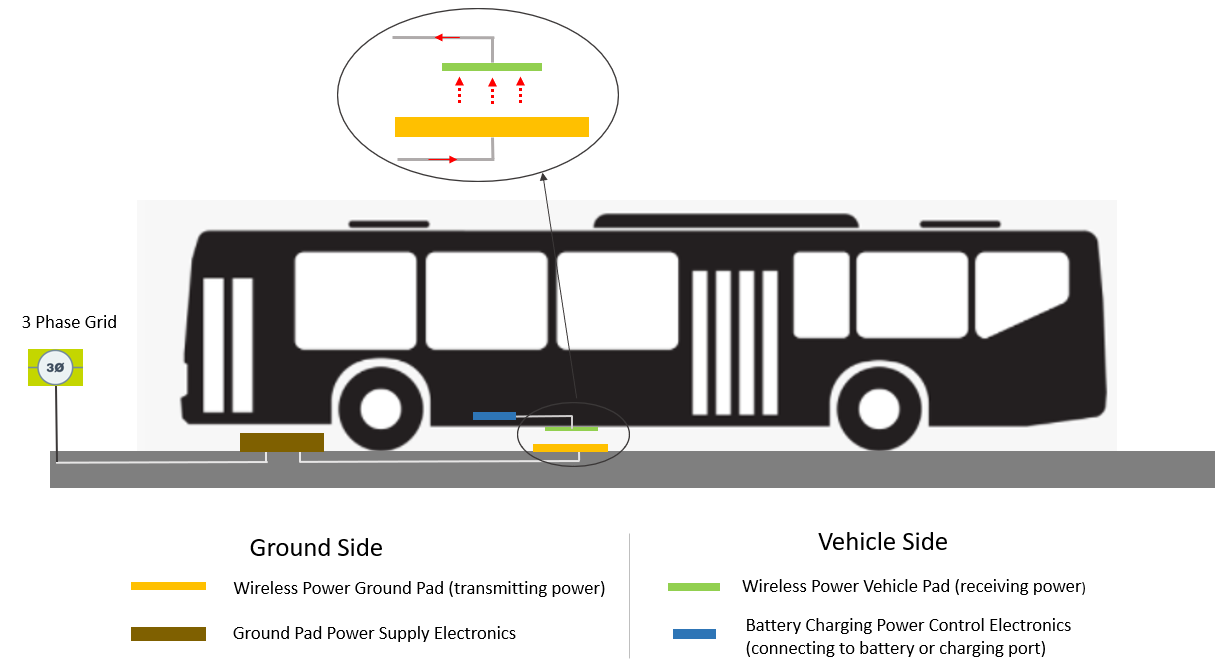
Induction charging. (Source: Auckland Transport)
|
Advantages |
Disadvantages |
|
|
For opportunity charging the speed of the connection is important, therefore, pantograph or induction are typically used, whereas for depot charging efficiency is important therefore plug in or pantograph are often used. Increasingly, technology is evolving to support chargers that are faster to connect and more efficient at charging. Depending on the manufacturer some battery electric buses can use multiple connection types (eg plug in and pantograph) while others have only one connection type.
The two types of pantograph charging systems are:
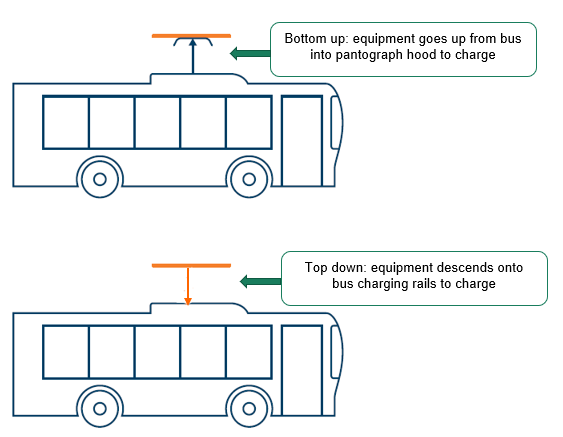
Pantograph (a) bottom-up and (b) top-down.
There are advantages and disadvantages to each type of pantograph and varied industry preferences for one or the other in New Zealand. Australia uses top down. Which is preferable is largely dependent on operational needs. Ensure whichever you choose, if you will be using pantographs at all, is compatible with your operational requirements such as the CCS2 plug type and the number of buses you would like to be charging at any given time.
Note that top-down pantographs have less equipment on the bus and more equipment on the overhead structure, this means less weight for the bus to carry but also means that the overhead structure must be stronger and bulkier. For bottom-up pantographs, the pantograph arm and electrical equipment is generally made lighter because this is carried by the bus and with less equipment on the overhead structure this can also be made lighter.
With bottom up, configuration failure of the charger mechanism requires the bus to be taken out of operation, whereas for top-down configuration the failure of the charger mechanism can impact on wider service delivery. Australia’s preference for top-down pantograph charging relates to a perception that it is more reliable than bottom-up and has lower maintenance costs, though these are still typically higher than plug-in charging maintenance costs.
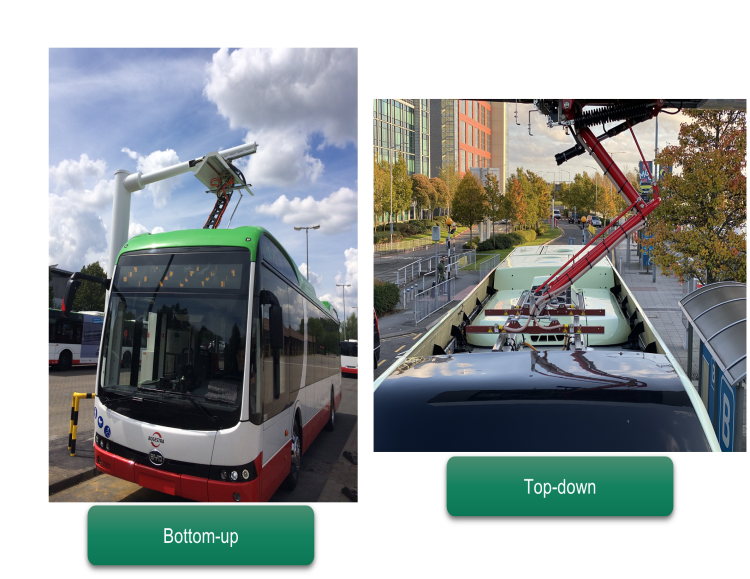
Pantograph types (a) top-down and (b) bottom-up. (source: ABB)
The typical characteristics of each type of pantograph are listed in the table below.
Table: Typical characteristics of each type of pantograph
(Source: Pirooz, A., Heidari Gandoman, F., Firouz, Y., & Van Mierlo, J. (2020). Feasibility study of reconfigurability between different power transmission concepts for electric bus charging. In Transport Research Arena)
|
Parameters |
Top-down |
Bottom-up |
Unit |
|
Maximum rated voltage |
1500 |
1000 |
VDC |
|
Nominal voltage |
750 |
750 |
VDC |
|
Charging current |
500 |
500 |
A |
|
Maximum current (<10min) |
600 |
800 |
A |
|
Electric lowering unit voltage |
24 ± 30% |
24 ± 30% |
VDC |
|
Contact force |
500 |
250 +10% |
N |
|
Total weight |
175~180 |
85 |
Kg |
|
Operational temperature |
-30 to +65 |
-30 to +65 |
°C |
In 2019 bus operator Tranzurban implemented 10 battery electric double deck buses in Wellington. These buses are used on route 1 (Island Bay to Churton Park/ Johnsonville West/ Grenada North) which is a 21km long route that has frequent services and gradients of up to 8%.
Each bus can carry up to 90 passengers and has a range of 150km on a single full charge. To extend the range the buses use a 450kW bottom-up pantograph charger at the Island Bay terminus to charge for 10 minutes during the layover and driver breaks.
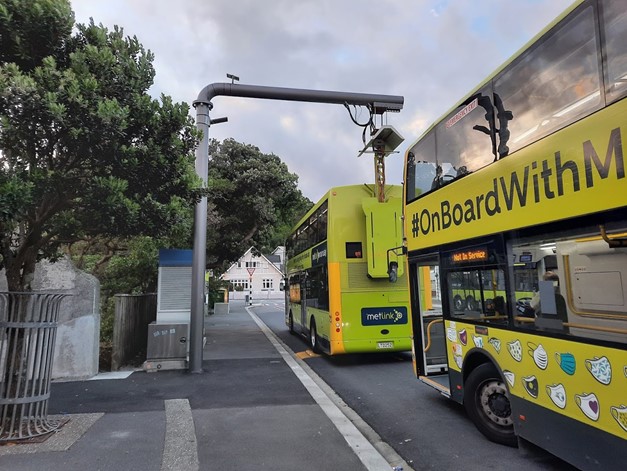
Battery electric double deck bus with pantograph opportunity charger. (Source: Lorelei Schmitt)
Lessons learnt: